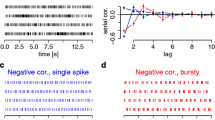Summary
A mathematical model is presented that is supposed to describe those types of neuronal discharges which show a preponderance of short intervals, as well as one or more preferred intervals of a longer duration. It is assumed that via two channels impulses impinge upon a nerve cell and that each impulse gives rise to a response. The intervals between impulses in one channel are distributed according to an exponential, or an exponential-like, function; those in the other channel are distributed according to a monomodal, or a multimodal, function.
The interval distributions and the expectation density (auto-correlation) functions of the model are in particular compared with data on thalamic neuron discharge patterns reported in the literature.
The properties of superimposed time series of events would seem to be of a wider interest, stretching beyond the field of theoretical neurophysiology. It is indicated how the theory is of use in the detection of hidden rhythms in records which are composed of a mixture of different signals.
Similar content being viewed by others
References
Amassian, V. E., J. Macy, H. J. Waller, H. S. Leader, and M. Swift: Transformation of afferent activity at the cuneate nucleus. In: Information processing in the nervous system (ed. by R. W. Gerard and J. W. Duyff), p. 235. Intern. Congress Series No. 49. Amsterdam: Excerpta Medica Foundation 1964.
Biscoe, T. J., and A. Taylor: The discharge pattern recorded in chemoreceptor afferent fibres from the cat carotid body with normal circulation and during perfusion. J. Physiol. (Lond.) 168, 332–344 (1963).
Bishop, P. O., W. R. Levick, and W. O. Williams: Statistical analysis of the dark discharge of lateral geniculate neurons. J. Physiol. (Lond.) 170, 598–612 (1964).
Conrad, R.: Speed and load stress in a sensori-motor skill. Brit. J. industr. Med. 8, 1–7 (1951).
Cox, D. R.: On the superposition of renewal processes. Biometrika 41, 91–99 (1954).
Gerstein, G. L., and W. A. Clark: Simultaneous studies of firing patterns in several neurons. Science 143, 1325–1327 (1964).
Heiss, W. D., u. H. Bornschein: Multimodale Intervallhistogramme der Daueraktivität von retinalen Neurone der Katze. Kybernetik 3, 187–191 (1966).
Lamarre, Y., and J. P. Raynauld: Rhythmic firing in the spontaneous activity of centrally located neurons. A method of analysis. Electroenceph. clin. Neurophysiol. 18, 87–90 (1965).
Moore, G. P., D. H. Perkel, and J. P. Segundo: Statistical analysis and functional interpretation of neuronal spike data. Ann. Rev. Physiol. 28, 493–522 (1966).
Parzen, E.: Stochastic processes. San Francisco: Holden Day, Inc. 1962.
Perkel, D. H.: Neurophysiological models: methods and applications. The Rand Corp. Memorandum RM-4247-NIH, p. 33. Santa Monica (Calif.) 1964.
Pfeiffer, R. R.: Input-output relations of neurons in the anteroventral cochlear nucleus, based on component analysis of wave-form. Abstract Seventy-First meeting of the Acoust. Soc. of America. J. acoust. Soc. Amer. 39, 1952 (1966).
Poggio, G. F., and L. J. Viernstein: Time series analysis of impulse sequences of thalamic sensory neurons. J. Neurophysiol. 27, 517–545 (1964).
Roberts, A. C.: Unit discharge in dorsal nucleus of the cat's lateral geniculate body. Acta physiol. pharmacol. neerl. 13, 1–80 (1964).
Taylor, A.: The significance of grouping of motor unit activity. J. Physiol. (Lond.) 162, 259–269 (1962).
Hoopen, M. Ten: Multimodal interval distributions. Kybernetik 3, 17–24 (1966a); - Impulse sequences of thalamic neurons. An attempted theoretical interpretation. Brain Res. 3, 123–140 (1966b).
Hoopen, M. Ten, and H. A. Reuver: The superposition of random sequences of events. Biometrika 53, 383–389 (1966); - Interaction between two independent time series. Inform. Control 10 (1967) (in press).
Viernstein, L. J., and R. G. Grossman: Correlation analysis of impulse trains of neurons of the cochlear nucleus. In: Proc. 18th Ann. Conv. Eng. in Med. and Biol., Philadelphia, 1965, p. 116 (P. L. Frommer and G. G. Vurek, eds.).
Werner, G., and V. B. Mountcastle: The variability of central neural activity in a sensory system, and its implications for the central reflection of sensory events. J. Neurophysiol. 26, 958–977 (1963).
Wilson, D. M.: The nervous co-ordination of insect locomotion. In: The physiology of the insect central nervous system (J. E. Treherne and J. W. L. Beament, eds.), p. 125. London and New York: Academic Press 1965a;- Nerve impulse patterns and reflex control in the motor system of the crayfish claw. J. exp. Biol. 43, 193–210 (1965b).
Author information
Authors and Affiliations
Rights and permissions
About this article
Cite this article
ten Hoopen, M. Pooling of impulse sequences, with emphasis on applications to neuronal spike data. Kybernetik 4, 1–10 (1967). https://doi.org/10.1007/BF00288820
Received:
Issue Date:
DOI: https://doi.org/10.1007/BF00288820




